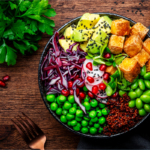Is it undeniable that you’ll suffer from indigestion or heartburn from holiday overeating? Do you have to roll your guests to their cars? Try adding fermented foods to the mix to beat the bellyaches!
fer▪men▪ta▪tion. noun. The chemical breakdown of a substance by bacteria, yeasts or other microorganisms.
Bacteria in foods? “Yuck,” many will say. But did you know fermented foods have been celebrated in many cultures for thousands of years1 and are found aplenty even in the American diet? Well, sort of…. Did you know you are aiding your body in digestion when consuming [most] yogurts and [some] sauerkrauts and pickles? I bracket those adjectives because many commercial foods we find in typical American grocery stores are not truly fermented (or “cultured” or “leavened”), just hopped up with white vinegar and salt. But that’s another article for another issue. Let’s stick to the delicious benefits of [true] fermented foods here. These are the ones we find most often in the refrigerated section of the store and contain the words “live cultures,” “live bacteria,” “probiotics” or “fermented” on the labels.
The power of fermented foods are as beneficial to the body as pungent to the palate. They are teeming with probiotics, microorganisms living in our digestive tract that aid in digestion and that most Americans likely need to boost. Prebiotics are the “food” that the probiotics consume in the gut to make them stronger and multiply. Stronger, healthy microflora in the body reduces risk of candida (or yeast overgrowth) which can lead to yeast infections and thrush. These conditions are especially at a higher risk after taking antibiotics, which essentially kill the “good” bacteria2.
Fermented foods are an easy way to boost digestive function.
Several studies have shown that consuming cultured foods regularly supports overall health and can even improve cognitive function, fight allergies, and may ease ailments/symptoms, such as3:
|
|
Fermenting foods at home is largely hands-off and relatively gadget-free with a half-hour prep and long wait step. Essentially you put food in a mason jar, add a brine with culture and wait for it to ferment. Below are 12 fermented foods with health benefits:
1. Apple Cider Vinegar
A natural tonic of fermented apple juice. As with most fermented foods, apple cider vinegar with the “mother” is considered a superfood, containing high nutrients (vitamins, minerals and antioxidants), but low calories. While fermentation turns sugars in the apple juice to alcohol, the secondary fermentation process turns the alcohol into acetic acid, creating the belly-pleasing “mother.” Health benefits are many and include reducing inflammation, lowering blood pressure and controlling blood sugar spikes4. I take a tablespoon anytime I feel a twinge of heartburn for instant relief. Apple cider vinegar with the “mother” has been found to have the following properties, helping with an array of illnesses and conditions5:
|
|
When heated, probiotics in many fermented foods begin to die. Try adding as a topping or mixing in at the end of cooking to best preserve their beneficial properties.
2. Cheeses – Raw and Aged
Made with unpasteurized (raw) milk from cows, goats or sheep. Why go raw? While pasteurization kills harmful bacteria such as salmonella, E. coli and listeria, it also kills the good, such as thermophillus, bifudus, bulgaricus and acidophilus, microflora needed in our digestive tracts*. And if the farm producing the raw cheese is clean and responsible, the risk of harmful bacteria in their milk is low. Nutritionist Katherine Zeratsky, RD, LD from the Mayo Clinic found evidence in probiotics treating diarrhea, yeast infections, UTIs, childhood eczema and IBS6. Most U.S. states allow the sale of raw cheese in some form; see where you fall on this interactive map.
Author’s Note: I added organic raw milk products to my household two years ago from a clean and responsible farm and have seen the immense health benefits; the numbness in my limbs discontinued, I no longer get random hives, my “bad” LDL cholesterol levels decreased, and I have more energy. For now, I have to go out of state to buy it since several U.S. states still ban it. Learn which states here.
3. Dosas
A South Indian crepe. Much milder in flavor than other fermented foods on this list, dosas are a gluten-free and dairy-free rice and lentil crepe with just as many probiotic benefits7. One South Indian soul food establishment in Vermont, Dosa Kitchen, describes them as having a, “sour, tangy flavor and airy, crisp texture.”
4. Kefir
A dairy drink. With a thinner consistency than (but similar taste as) yogurt, kefir may be an anti-inflammatory food and help lower blood pressure. It is high in protein which supports weight loss efforts by making people feel fuller longer8 and full of calcium, vitamins B12, K2 and D, phosphorus, riboflavin (B2), magnesium, enzymes and, of course, probiotics9.
5. Kimchi
A staple Korean condiment of vegetables and spices. Traditionally made of cabbage, kimchi can also contain radish and/or carrot mixed with spices like garlic, salt or fish/soy sauce, onion, pepper and/or ginger. It is also high in vitamins A, B and C.10 If buying in the grocery store, be sure it doesn’t contain vinegar, a tell-tale sign the product isn’t truly fermented.
6. Kombucha
An effervescent sweet black tea. Typically consumed cold to keep its probiotics intact, the sugar is turned to a low-level of alcohol during fermentation (no, you won’t get buzzed). The Kombucha bacteria produces antioxidants that help fight against free radicals (toxins) seen in cancers and inflammatory illnesses. Kombucha is thought to promote immune system health and possibly counter some metabolic disorders11.
7. Kvass
A beverage similar to kombucha above. Kvass, popular in Russia, is traditionally made from fermenting stale, sourdough rye bread tasting much like beer, or from beets. The drink is high in manganese, vitamin B12, selenium, niacin, iron, copper and magnesium12. One of my go-to books by Sally Fallon Morell, Performance without Pain, suggests drinking 4 oz. of beet kvass morning and night each day to promote regularity and cleanse the liver.
8. Natto
Natto are sticky soybeans. Used often in spreads and soups in Japan, natto is high in protein, fiber, vitamins B and K2 and iron, favored as it is lower in sodium than miso (see #10 below) or soy sauce. Including natto in your diet may lower your levels of osteoporosis, according to Dr. Dennis Goodman at New York University13.
9. Pickles
Crunchy, cultured cucumbers. Once in a brine solution, the salt draws out cucumbers’ high water content, leaving a high concentration of vitamins, like A, C and K, as well as calcium and potassium14. Most supermarket pickles swim in vinegar, so you’ll have to make your own to get full fermentation benefits.
10. Sauerkraut
Sauerkraut is “sour cabbage.” Believed to first be made by the Chinese over 2,000 years ago, Europeans adopted the process of fermenting cabbage in the 16th This superfood is low in calories, but high in folate, vitamins B6, C and K, riboflavin, thiamin, iron, potassium and magnesium. It was found that consumption of sauerkraut could lower breast cancer risk by 74% in a study by the University of New Mexico and supported by the American Association for Cancer Research15!
11. Tempeh/Miso
Tempeh/miso is a protein-rich soybean-based Japanese food. Tempeh has a consistency similar to tofu with a nutty flavor, and Miso is a paste often used in soups and sauces. Fermenting soybeans is thought to release beneficial peptides, amino acids that help regulate bodily functions, which may reduce the risk of diabetes and cancer, fight infections and lower blood pressure16.
12. Yogurt
Yogurt is the most consumed fermented dairy product in the U.S. Yogurt is high in protein, calcium, phosphorus and B vitamins: riboflavin and B1217. I recommend you always choose organic or grass-fed options for the “cleanest eating,” but watch the sugar count from added fruits/sweeteners; plain is best. If you have trouble digesting lactose, try sheep’s or goat’s yogurt.
Try adding one to each meal or even use as between-meal snacks to keep your gut healthy and indigestion free, especially around the holidays when people tend to overeat (and pay the price later). See this recipe for easy fermented pickles*.
*Always consult your healthcare practitioner before making changes to your diet. People with weakened immune systems due to such conditions as pregnancy and HIV, or the elderly, for example, or who are taking many medications may be cautioned against consuming homemade fermented foods.
1Living History Farms, “Beyond Sauerkraut: A Brief History of Fermented Foods
2 Medical News Today, “What are the best fermented foods?”
3 Ibid.
4 Reader’s Digest, “Pucker Power for Better Blood Sugar”
5 Medical News Today, “What are the best fermented foods?”
6 Livestrong.com, “What Raw Cheese Has Probiotics?”
7 Forbes, “Fermented Foods You Can Make at Home Fast”
8 Medical News Today, “What are the best fermented foods?”
9 Healthline, “9 Evidence-based Health Benefits of Kefir”
10 Health, “World’s Healthiest Foods: Kimchi”
11 Medical News Today, “What are the best fermented foods?”
12 Organic Facts, “5 Amazing Benefits of Kvass”
13 Well, “Are You Ready to Eat Your Natto?”
14 WebMD, “What Pickles Can Do for Your Health”
15 GermanFoods, “Sauerkraut, Germany’s Superfood”
16Medical News Today, “What are the best fermented foods?”
17 Harvard T.H. Chan School of Public Health, “The Nutrition Source: Yogurt”














